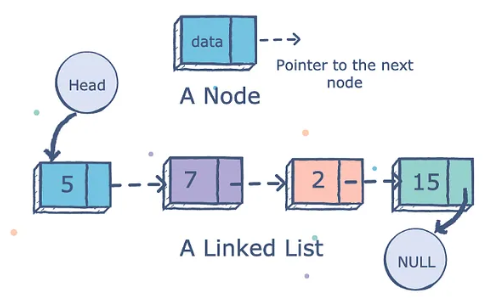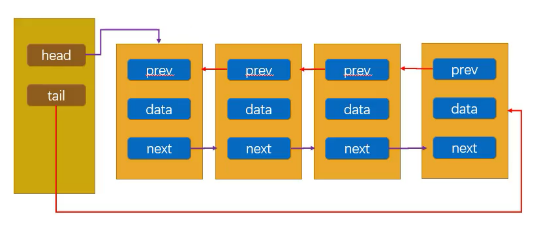| 数据结构 | 是否为线性结构 | |
|---|---|---|
| 数组(Array) | 是 | |
| 链表(LinkedList) | 是 | |
| 栈(Stack) | 受限的 | |
| 队列(Queue) | 受限的 |
# 一、链表
# 1、认知
在 JavaScript 中,并没有自带链表结构,需要我们自己实现。
并且,不同与数组,链表中的元素在内存中不必是连续的空间。
# 2、特点
链表中的每一个元素由存储本身的节点和下一个元素的引用(有些语言也称为指针)组成。
缺点是:无法通过下标访问,从头开始访问的方式效率低。

# 二、单向链表
参考:https://medium.com/swlh/anatomy-of-a-singly-linked-list-in-js-4e7452fec600
# 1、链表结构
- A Node
// A Node
class LinkedListNode<T> {
element: T
next: LinkedListNode<T> | null = null // 默认值为null
constructor(element: T) {
this.element = element
}
}
- A Linked List
// A Linked List
class LinkedList<T> {
head: LinkedListNode<T> | null = null
private size: number = 0
// 根据index获取对应的LinkedListNode节点
private getNodeByIndex(index: number): LinkedListNode<T> | null {
let current = this.head
let num = 0
while (num++ < index && current) {
current = current.next // 更新current节点
}
return current
}
// ---
// ……
// ---
}
export default LinkedList
# 2、设计实现
LeetCode:设计链表 (opens new window)
在手动编写代码的时候,可以想象一下 splice方法是怎么实现的 😂
class LinkedList<T> {
// ……
// ---
peek(): T | undefined {
return this.head?.element
}
get length(): number {
return this.size
}
isEmpty(): boolean {
return this.size === 0
}
clear(): void {
this.head = null
}
// -----------------------
// -----------------------
// 1、尾部追加
append(element: T) {
const newLinkedListNode = new LinkedListNode(element)
// 判断是否为空链表
if (this.head === null) {
this.head = newLinkedListNode
} else {
let current = this.head // 临时变量current最终会被销毁
while (current.next !== null) {
current = current.next
}
// 最后一个element的 next 指向新增的 newLinkedListNode
current.next = newLinkedListNode
}
this.size++
}
// 2、遍历element
traverse(): T[] {
const result: T[] = []
let current = this.head
while (current) {
result.push(current.element)
current = current.next
}
return result
}
// 3、获取元素索引值
indexOf(checkElement: T): number {
let current = this.head
let index = 0
while (current) {
if (current.element === checkElement) {
return index
}
current = current.next
index++
}
return -1
}
// -----------------------
// -----------------------
// 1、插入元素
insert(element: T, start: number) {
// 越界判断
if (start < 0 || start > this.size) return false
const newLinkedListNode = new LinkedListNode(element)
let current = this.head
// 判断头部插入
if (start === 0) {
// 注意顺序
newLinkedListNode.next = current
this.head = newLinkedListNode
} else {
const previous = this.getNodeByIndex(start - 1)
current = previous!.next
previous!.next = newLinkedListNode
newLinkedListNode!.next = current
}
this.size++
}
// 2、删除元素
removeByIndex(index: number): T | null {
// 越界判断
if (index < 0 || index > this.size) return null
let current = this.head
// 判断头部删除
if (index === 0) {
this.head = current?.next ?? null
} else {
const previous = this.getNodeByIndex(index - 1)
current = previous!.next
previous!.next = current?.next ?? null
}
this.size--
return current?.element ?? null
}
// 3、查看元素
getByIndex(index: number): T | null {
// 越界判断
if (index < 0 || index > this.size) return null
const current = this.getNodeByIndex(index)
return current?.element ?? null
}
// 4、更新元素
update(index: number, newElement: T) {
// 越界判断
if (index < 0 || index >= this.size) return false
const current = this.getNodeByIndex(index)
current!.element = newElement
return true
}
// ---
}
# 3、练习:反转链表
LeetCode:反转链表 (opens new window)
- 栈
function reverseList(head: ListNode | null): ListNode | null {
if (head === null) return null
if (head.next === null) return head
// 初始化一个栈
const stack: ListNode[] = []
// 入栈
let current: ListNode | null = head
while (current) {
stack.push(current)
current = current.next
}
// 出栈
const newHead: ListNode = stack.pop()! // 新链表
let newCurrent: ListNode | null = newHead
while (stack.length) {
newCurrent.next = stack.pop()!
newCurrent = newCurrent.next
}
newCurrent.next = null // 收尾
return newHead
}
- 迭代
function reverseList(head: ListNode | null): ListNode | null {
if (head === null || head.next === null) return head
let newHead: ListNode | null = null // 新链表
while (head) {
let current: ListNode | null = head.next
head.next = newHead
newHead = head
head = current
}
return newHead
}
- 递归
function reverseList(head: ListNode | null): ListNode | null {
if (head === null || head.next === null) return head
const newHead: ListNode | null = reverseList(head?.next ?? null) // 新链表
// ListNode节点的next指向(向前推进)
head.next.next = head
head.next = null
return newHead
}
# 三、循环链表
在 单向链表 基础上进行拓展的一种数据结构,详见:
https://github.com/Lencamo/note-taking-case/tree/main/data-structure-ts-code/03_LinkedList
# 图示

# 四、双向链表
在 单向链表 基础上进行拓展的一种数据结构,详见:
https://github.com/Lencamo/note-taking-case/tree/main/data-structure-ts-code/03_LinkedList
# 图示

